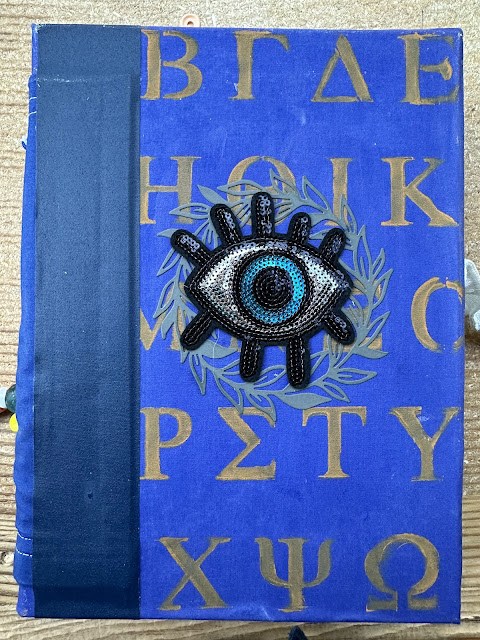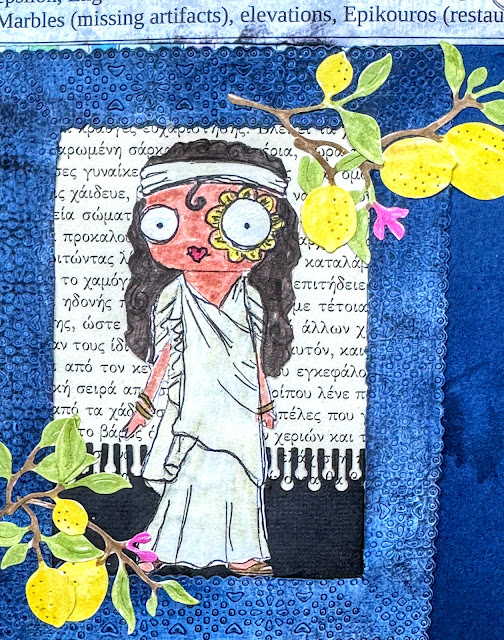Hi everyone. Happy Friday. I hope everyone has had a great week and will have a nice weekend ahead. Today I am linking up to Gillena's Friday Lunch Break and Nicole's Friday Face Off.
Last week I finished up and bound my Greece travel journal. Some of you already know, but for those who don't, I save lots of scraps from my trip, and when I get home I like to make a journal about my trip. It's not exactly a scrapbook, and I rarely include photos. I try my hand at making scenes; I do a bunch of collage, and there's also some stamping too.
Let me show you my cover and bound journal first.
I used a blue fat quarter of fabric to cover an old book cover. I cut the cover boards off of the book by removing the spine and pages, then I added the fabric to both cover pieces. After the matte medium dried, I stenciled on some Greek letters, added a die cut of a wreath (to mimic a laurel or olive wreath), and then I added this evil eye applique. I found the applique marked down on a sale rack after I was home from the trip. The back is similar to this front except for there is only the stenciled blue fabric cover.

I tried something different for the binding this time. It's a little flexible, but overall I like it. I took some more of the blue fabric, folded it over a few times and added some rigid sewing interfacing to it. All that is sewn together. It's a little shorter than the front and back covers, but I did that on purpose because I thought it would look nice to have the edges of the pages sticking out on the top and bottom. I used some super sticky tape to attach it to the front and back covers, and then I took some blue bookbinding tape (which I bought for this project) to hold it together. If you've never used bookbinding tape it is great stuff. It is very sticky fabric tape, and it can be used for a book binding by itself.
You can see from the binding that this journal is quite thick. You can also see where I stitched in the signatures of my journal (using wax book binding thread). Then I stitched in this blue and white "bracelet that I got for free in Athens. On one end, where you would tie it around your wrist, I added some beads from my stash.
Since I am linking up to Nicole's
Friday Face Off, let me share some "faces" from this journal. These are mostly snippets of pages and not the whole page. These first few pages include some postcards I bought or snippets of postcards that I cut apart.
On this next page I added this stamped image after I found the rubber stamp in my stash (I forgot I even had it). Of course I had to add him to the book.
And this bakery bag came from a breakfast treat in Corfu. The owl is from a bookmark I bought.
And more postcard creations.
Here's an image I printed off the internet. I learned about St. Barbara when I visited Meteora.
Does the Starbucks face look familiar to anyone? My daughter wanted one of their mugs that said Greece. This is off the bag it came in.
The tour groups in this next photo were not at the Acropolis when I visited. I cut this photo out of an old book because it worked well.
And finally, a patch I did buy in Athens, but I added the little glass pieces to the eyes.
I still have some Greece photos to share which I will hopefully get back to soon.
Have a super weekend ahead.



















































